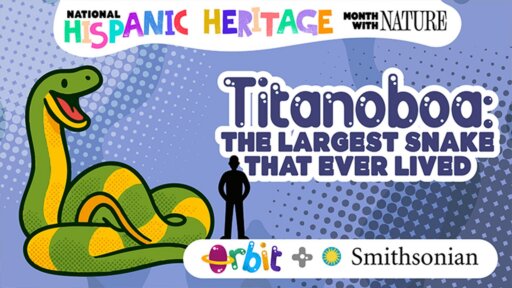TRANSCRIPT (EN)
00:00:00 Robert:
Hi there, Rob here.
00:00:01 Robert:
This episode is part of a bilingual children’s podcast series for National Hispanic Heritage Month — a collaboration between PBS Nature and Cumbre Kids.
00:00:10 Robert:
This series features scientists from leading museums, zoos, and aquariums across the United States, responding to questions submitted by children ages three to ten.
00:00:20 Robert:
These episodes appear on the podcasts Orbit: Science for Kids on the Move, Cráneo: Ciencia para niños curiosos, and Camaleón: Animales para niños curiosos.
00:00:30 Robert:
Our podcast is for families with children ages three to ten.
00:00:33 Robert:
And you can find it on YouTube, Spotify, Apple Podcasts, or wherever you listen to podcasts.
00:00:38 Robert:
Just a heads up—
00:00:39 Robert:
This episode is in Spanish.
00:00:41 Robert:
We hope you enjoy it!
00:00:42 Gerwuin:
Hello, parents!
00:00:44 Gerwuin:
This episode is part of a special celebration for Hispanic Heritage Month.
00:00:48 Gerwuin:
We want to give a special thanks this month to the PBS Nature team, who have been amazing collaborators in making this content possible.
00:00:56 Gerwuin:
And if your little ones want to send in their questions, they can go directly to www.cumbrekids.org/preguntas
or use the link in the description.
00:01:06 Gerwuin:
All right, let’s get started!
00:01:09 Gerwuin:
Okay, chameleons! Imagine you’re standing in the middle of the African savanna.
00:01:19 Gerwuin:
The wind moves through the tall grass, and suddenly you hear a roar so powerful it makes the ground tremble.
00:01:30 Gerwuin:
Looking closer, you spot a group of lions resting together in the shade of a tree—
00:01:37 Gerwuin:
Mothers, playful cubs, and a big male with a mane shining in the sun.
00:01:42 Gerwuin:
Today, we’re going to learn more about these incredible animals that live in prides and have been symbols of strength for thousands of years.
00:01:51 Children:
The way lions communicate with their tails is just as effective as their roars and other sounds!
00:02:00 Children:
How do lions hunt?
00:02:02 Gerwuin:
And joining us today is a very special guest — Joaquín from the Phoenix Zoo — who will tell us everything about the lives of African lions!
00:02:15 Gerwuin:
Okay, chameleons!
00:02:18 Gerwuin:
How’s everyone doing? Welcome to another episode of Camaleón! I’m joined, as always, by Isabella. Hi Isa, how are you?
00:02:29 Isabella:
Very good, very good! And hello as well to our mini listeners and to their families who make this podcast possible!
00:02:35 Gerwuin:
That’s right — welcome everyone, and thank you for being here! Isa, tell me — what’s been going on in your life?
00:02:41 Isabella:
So many things! I’ve been breathing, eating, doing a million different things!
00:02:50 Gerwuin:
Okay, okay — just tell me one thing, that’s enough!
00:02:54 Isabella:
Well, the other day they called me to the front of the class because I was the best among all the third graders in my school!
00:03:05 Gerwuin:
Really? So they called you up for what?
00:03:09 Isabella:
To give me an award for the best academic performance!
00:03:12 Gerwuin:
That’s awesome! I bet we have lots of chameleons listening who are just as smart as you.
00:03:18 Isabella:
I hope so! And if not, and they don’t do their homework, then— tuki tuki lulú for them!
00:03:26 Gerwuin:
Tuki tuki lulú! Very good!
00:03:34 Isabella:
Okay friends, before we continue, I want to recommend a book called How to Tame Your Parents.
00:03:43 Gerwuin:
Wait, what? Isa’s holding a book called How to Tame Your Parents?
00:03:52 Isabella:
Yes! And it’s about… well, how to tame your parents.
00:03:57 Gerwuin:
Why do you need to tame your parents?
00:04:01 Isabella:
Because I want to!
00:04:03 Gerwuin:
And what’s the book about, Isa?
00:04:06 Isabella:
It tells us how we can “tame” our parents — by doing what they ask, treating them with love… but really, we’re manipulating them!
00:04:20 Gerwuin:
And who wrote that book, Isa?
00:04:22 Isabella:
It was written by Mauricio Paredes.
00:04:25 Gerwuin:
Well, jokes aside, that’s actually a very interesting book! So to all the parents out there — if you get a chance, buy this book for your kids: How to Tame Your Parents!
00:04:36 Gerwuin:
That’s Isa’s big recommendation!
00:04:40 Isabella:
The big recommendation!
00:04:42 Gerwuin:
I needed that book in my life when I was your age — but I never had it!
00:04:47 Isabella:
Pi pi pi pi pi pi pi pi!
00:04:51 Gerwuin:
All right Isa, today we’re going to talk about the African lion — known as the “King of the Jungle,” even though it actually lives in the savanna.
00:04:59 Isabella:
Yes! And something really curious — when lion cubs are born, they weigh less than 4 kilos and are completely dependent on their mothers. And look how they grow up to become the kings of the jungle!
00:05:15 Gerwuin:
Can you imagine? So fast! Well, not that fast — they spend time with their parents and stay hidden during their first few weeks to protect themselves from other predators.
00:05:27 Isabella:
That’s true! And lions can sleep up to 20 hours a day — they’re such royal sleepyheads!
00:05:35 Gerwuin:
Wow! Who wouldn’t want to be a lion and sleep that much? How nice!
00:05:42 Gerwuin:
And what’s interesting is that all that rest time is actually important — it helps them recover their strength and be ready to hunt or defend the pride. See? Sleeping is important!
00:05:53 Isabella:
And even though it doesn’t seem like it, some lions actually like to climb trees — especially in certain parts of Africa.
00:06:02 Gerwuin:
That’s right, very good, Isa! But now let’s describe the lions we’re seeing on the screen. What do you see, Isa?
00:06:10 Isabella:
The first lion looks like he has a tooth box — that tooth looks rotten!
00:06:15 Gerwuin:
A rotten tooth?
00:06:17 Gerwuin:
How many teeth does a lion have?
00:06:20 Gerwuin:
We don’t really know, do we?
00:06:21 Gerwuin:
If we count from here… one, two, three, four, five, six, seven, eight, nine, ten — so many!
00:06:28 Isabella:
And look at those fangs — they look just like Dracula’s!
00:06:32 Gerwuin:
Yes! Huge! Those fangs must be really powerful.
00:06:36 Gerwuin:
Although I think they’re even stronger with their claws, right?
00:06:39 Gerwuin:
What do you think?
00:06:40 Isabella:
Yeah! And the other lion looks super calm, just waiting to see what shows up.
00:06:45 Gerwuin:
What could be showing up?
00:06:46 Gerwuin:
Maybe a lioness — or maybe some prey they’re hunting?
00:06:51 Isabella:
Yes! And the lion with the “tooth box” is yawning!
00:06:54 Gerwuin:
Yes, he’s yawning — and also kind of scaring everyone at the same time!
00:06:59 Isabella:
Yeah, if a lion stood in front of me yawning like that—
00:07:04 Gerwuin:
You’d faint, right?
00:07:07 Gerwuin:
Tuki, tuki, Lulú!
00:07:08 Isabella:
Tuki, tuki, Lulú!
00:07:11 Gerwuin:
Okay, Isa — let’s sing a really fun lion song for all the kids. What do you say?
00:07:16 Isabella:
And everyone, stand up so you can dance with us! Sing, shout, jump — do whatever you want!
00:07:25 Gerwuin:
Do whatever you want!
00:07:27 Gerwuin:
That’s right — this is the moment to dance and learn with the Camaleón song, and especially with the lion song!
00:09:21 Isabella:
We did it! We did it, we did it a thousand times over! And now, Gerwuin, let’s introduce our special guest. Today we’re joined by Joaquín from the Phoenix Zoo!
00:09:35 Isabella:
Hi Joaquín! Do you have a favorite animal?
00:09:37 Joaquín:
Hi! My name is Joaquín. I work here at the Phoenix Zoo, and we have so many animals — but I think my favorite is the African lion.
00:09:47 Joaquín:
And not just because they’re such impressive animals, but because they’re so complex, and beautiful, and just incredible creatures.
00:09:56 Isabella:
That’s awesome!
00:09:56 Isabella:
And what do you do exactly at the zoo?
00:09:59 Joaquín:
Well, I’m the photographer and videographer here at the Phoenix Zoo, but I also work a lot with the animals we take out to news stations, schools, or hospitals — they’re usually small animals, like snakes or birds.
00:10:14 Isabella:
And what’s a workday like for you, surrounded by so many animals at the zoo?
00:10:20 Joaquín:
Every day is non-stop! Basically, I’m running around taking photos and videos of all the animals — for birthdays, special holidays, or any occasion. I’m there with them — even when new babies are born!
00:10:34 Gerwuin:
All right, Isa — what do you say we go meet this African lion? Let’s do it!
00:10:41 Gerwuin:
All right! Let’s dive into today’s topic. Joaquín, let’s talk about the African lion and the places where it lives. Tell us — what is this famous animal like?
00:10:50 Joaquín:
Well, I think the African lion is probably the most famous cat of all the cats.
00:10:56 Gerwuin:
Oh really? I thought it was the tiger! But you’re right — lions appear in movies, in paintings from long ago — that really makes them super famous!
00:11:06 Joaquín:
The males can grow to almost 500 pounds —
00:11:10 Joaquín:
And of course, they have that big mane — the one everyone recognizes — that makes them a symbol of strength.
00:11:18 Joaquín:
They’re also one of the only kinds of cats that can live in such large family groups.
00:11:23 Gerwuin:
Ah, interesting!
00:11:24 Gerwuin:
So they’re not only strong and impressive, but also social — which isn’t very common among cats!
00:11:30 Joaquín:
Well, normally, a lion pride has about forty lions.
00:11:34 Joaquín:
That’s kind of the average — sometimes there are a few more, sometimes a few less.
00:11:39 Joaquín:
But around forty — lots of females, some cubs, and usually just one male.
00:11:47 Gerwuin:
All right, Joaquín, are you ready to answer the chameleons’ questions?
00:11:52 Daniel:
Hi! I’m Daniel Cabrera, I’m five years old, and I live in Ecuador. My question is:
00:12:00 Daniel:
Why are there so many lionesses but only one male?
00:12:05 Joaquín:
Well, that’s just how lions are structured.
00:12:08 Joaquín:
Normally, male lions don’t like to share with other males.
00:12:12 Joaquín:
They want to have their own pride — their own group — so they can have their own cubs.
00:12:16 Joaquín:
They’re very territorial and don’t like to share.
00:12:19 Gerwuin:
So, in other words, every male wants to be the only king of his pride!
00:12:24 Gerwuin:
Now that’s defending your crown!
00:12:26 Logan:
Hi! I’m Logan, I’m nine years old, I live in Mexico, and my question is: Can there be two male lions in the same pride?
00:12:30 Joaquín:
Hi Logan! Well, sometimes there can be more than one male. Normally, there’s just one, and he has cubs with the lionesses — but sometimes there are lions in the group that aren’t his cubs. Sometimes he might have a brother there too, but that brother has to be more submissive — not the dominant one. There can only be one king in the pride!
00:12:58 Joaquín:
And sometimes there are smaller groups made up only of males — younger males who live together.
00:13:04 Gerwuin:
I remember I always tried to beat my older brother when we wrestled — and he always won! But still, I thought I was the king of the house.
00:13:13 Gerwuin:
Well… that’s what I believed anyway!
00:13:16 Gerwuin:
Hey Joaquín, how do lions decide how many males there are and what role each one plays in the group?
00:13:23 Joaquín:
They fight.
00:13:24 Joaquín:
There are lots of fights between them.
00:13:26 Joaquín:
Not to the death — but usually until one says, “Okay, okay, I get it, you’re stronger.”
00:13:30 Joaquín:
And once they fight, that’s how it’s decided who’s the dominant male.
00:13:35 Gerwuin:
Of course! I imagine age has something to do with it too — because older lions don’t have as much strength anymore, right?
00:13:42 Joaquín:
Sometimes a slightly younger male comes along, sees an older lion, and says, “Ah, I’m stronger than him — I can take him on.”
00:13:51 Joaquín:
But sometimes those older lions — they really know how to fight!
00:14:02 Gerwuin:
Incredible, chameleons! A pride isn’t just a bunch of lions living together —
00:14:07 Gerwuin:
It’s like a big family with clear rules.
00:14:10 Gerwuin:
In the world of lions, even how they stand, roar, or look at each other says a lot.
00:14:16 Gerwuin:
That’s how every member knows who’s in charge and who must show respect.
00:14:21 Gerwuin:
When two males face off, it’s not just a fight — it’s how the entire group decides who leads and how everything is organized.
00:14:29 Gerwuin:
The most important thing in a pride is protecting the cubs and keeping order.
00:14:32 Gerwuin:
The dominant male is the one with the most strength and authority.
00:14:37 Gerwuin:
If another male arrives and wins a fight, then the whole family hierarchy changes.
00:14:43 Gerwuin:
That kind of reminds us a bit of humans.
00:14:46 Gerwuin:
We also live in groups with leaders, rules, and responsibilities.
00:14:51 Gerwuin:
We don’t use physical strength like lions do, but we look for the same thing — to keep our group organized and safe.
00:14:59 Gerwuin:
Scientists have discovered something very interesting.
00:15:02 Gerwuin:
Sometimes young lions team up — almost like friends helping each other — to try to take over a pride.
00:15:09 Gerwuin:
That shows that it’s not always about fighting; there’s cooperation too!
00:15:18 Gerwuin:
All right — it’s time for our Camaleón Moment!
00:15:21 Gerwuin:
But this time, the sound won’t be from an animal.
00:15:24 Gerwuin:
So we’re changing things up — our podcast is turning mysterious while we try to figure out a very special sound you’re about to hear.
00:15:36 Gerwuin:
What sound could it be?
00:15:39 Gerwuin:
Got it?
00:15:39 Gerwuin:
All right — tell me your guesses at the end!
00:15:52 Francisco:
Hi, my name is Francisco, and my question is: How do lions hunt?
00:15:57 Joaquín:
Hi Francisco! Well, since lions live in groups of more than 40 together, they hunt many kinds of animals in Africa — deer, buffalo — and they work as a team. But it’s the females who do most of the hunting. They’re the ones who go out there!
00:16:14 Gerwuin:
Oh, that’s interesting!
00:16:15 Gerwuin:
So lions have a great team in their pride.
00:16:19 Gerwuin:
And what do the males do while the lionesses hunt?
00:16:21 Joaquín:
They don’t usually hunt — they only help when the pride needs the strength of a male.
00:16:25 Joaquín:
If they’re going after really big prey, then yes, the male helps. But normally, it’s the females — they’re very smart, and by working together they can catch lots and lots of animals.
00:16:38 Gerwuin:
Very good! That teaches us something important —
00:16:40 Gerwuin:
Strength isn’t always the most valuable thing.
00:16:43 Gerwuin:
For lionesses, what really matters is teamwork and intelligence when they hunt together.
00:16:49 Gerwuin:
Hey Joaquín, what strategies do the lionesses and the male use when it’s time to hunt?
00:16:54 Joaquín:
These animals can run more than 50 miles per hour! But even though they’re so fast, they don’t just spot an animal and start running.
00:17:02 Joaquín:
They hide in the tall grass, keeping very low, and only start running when the time is right. They jump onto the animal — and if it’s a big one, all the lionesses join in. They use their sharp teeth—
00:17:18 Joaquín:
—biting, usually right on the neck.
00:17:22 Gerwuin:
Wow, I can’t imagine a really hungry lioness!
00:17:25 Clemente:
Hi! I’m Clemente, I’m 8 years old, I live in León, Guanajuato, Mexico, and my question is: Is the way lions “talk” with their tails as effective as their roars and other sounds?
00:17:49 Joaquín:
Lions have something really special — they can communicate with their tails! They use them almost like flags. Since they have so much fur on their tails, they wave them to signal to other lionesses things like “stay low,” “I’m scared,” or “attack.”
00:18:09 Gerwuin:
What a cool way to talk in silence — just by moving their tails, they can give instructions to the whole pride!
00:18:16 Joaquín:
Sometimes they even use their tails—
00:18:18 Joaquín:
—to communicate with their cubs, telling them “stay low.” When they’re walking through tall grass, sometimes the tail is all the cubs can see — it’s like a little flag guiding them.
00:18:29 Isaí:
Hi! I’m Isaí, I’m 8 years old. My question is: From how far away can you hear a lion’s roar?
00:18:41 Joaquín:
It’s one of the loudest roars in the world — you can hear it from more than 5 miles away!
00:18:46 Joaquín:
And you can feel those roars when you’re standing nearby.
00:18:50 Gerwuin:
Wow, amazing!
00:18:51 Gerwuin:
That means they can be heard from over 8 kilometers away — like putting 80 soccer fields in a row and still hearing the sound!
00:19:02 Kenji:
Hi chameleons! I’m Kenji, and I live in Aguascalientes.
00:19:07 Kenji:
And my question is — what do lions do to communicate when they’re in danger?
00:19:16 Joaquín:
Well, with that roar — since it can be heard from more than 5 miles away — that’s how they tell other lions or animals, “Hey, I’m here! I’m a lion!” It’s a warning to stay back. But they can also communicate in other ways that aren’t as loud as a roar.
00:19:38 Joaquín:
They make softer sounds — even little meows — kind of like the cats you see at home.
00:19:45 Gerwuin:
Incredible, chameleons!
00:19:47 Gerwuin:
Lions have an entire language of sounds and gestures that helps them stay safe and united.
00:19:53 Gerwuin:
Want to hear some of them?
00:19:55 Gerwuin:
Here they are!
(Sound effects of lions roaring and growling)
00:20:07 Gerwuin:
Chameleons, now I want us to think about another fascinating aspect — territory.
00:20:12 Gerwuin:
Lions need huge spaces to live because that’s where they find water, shade, and most importantly — food.
00:20:20 Gerwuin:
A single pride can occupy dozens of square kilometers — like a huge neighborhood in the middle of the savanna.
00:20:27 Gerwuin:
Biologically, they mark their territory with scent, roars, and even paw prints on the ground.
00:20:34 Gerwuin:
It’s a way of sending clear messages to other lions:
00:20:38 Gerwuin:
“This place is already taken.” That way, they avoid unnecessary fights, and each group knows where it’s safe to roam.
00:20:45 Gerwuin:
Scientists have discovered that the size of a lion’s territory depends on how many resources are available.
00:20:52 Gerwuin:
If there’s lots of food and water, the territory can be smaller because everything they need is close by.
00:20:57 Gerwuin:
But if resources are scarce, the pride has to travel greater distances and defend larger areas.
00:21:04 Gerwuin:
It’s also been found that lions take a very active role in guarding their territory.
00:21:09 Gerwuin:
They patrol, keep watch, and teach the cubs to recognize the boundaries.
00:21:14 Gerwuin:
That helps keep the pride protected and organized.
00:21:18 Gerwuin:
Okay, but let’s keep listening to our mystery sound.
00:21:21 Gerwuin:
What could this sound be?
00:21:24 Gerwuin:
Could it be the sound of an insect?
00:21:28 Gerwuin:
Could it be a drone? Or maybe a spaceship?
00:21:37 Gerwuin:
Got it?
00:21:39 Gerwuin:
Great — tell me at the end!
00:21:42 Kenji:
Hi, my name is Kenji, I’m five years old, I live in the United States, and my question is: Do lions have predators?
00:21:53 Gerwuin:
Hi Kenji — that’s a good question. Do lions have any predators?
00:21:59 Joaquín:
Well, unfortunately, yes. Life isn’t always easy for lions. Their main threats are other lions and humans.
00:22:11 Joaquín:
Sadly, many humans hunt lions, and lions also lose their homes because of human activity — we build and change things that destroy their habitats.
00:22:24 Gerwuin:
That’s right — and it reminds us that even though lions seem very powerful, nature is always full of challenges.
00:22:31 Gerwuin:
Cubs especially depend a lot on the care of their mothers and the whole pride.
00:22:37 Lua:
Hi! My name is Lua, I’m seven years old, I live in Santiago, Mexico, and my question is: Why are lions called the kings of the jungle? Bye! Have a great day!
00:23:01 Joaquín:
Well, I think they got that name because of their manes — they look like crowns! Lions are big, strong, and the way they live together feels like a kingdom — there’s a king, there are queens, and they even fight with other prides, like kingdoms do. Lions have always been symbols of strength.
00:23:15 Joaquín:
So that’s why people see them as kings — they’re impressive, powerful animals.
00:23:21 Gerwuin:
Of course! But it’s important to remember that in nature, there isn’t just one king.
00:23:26 Gerwuin:
Other animals have amazing abilities too — like African wild dogs, for example, which are very successful hunters.
00:23:33 Gerwuin:
Every species has its own way of being powerful.
00:23:36 Gerwuin:
We’re reaching the end of today’s episode, chameleons! But before we go, let’s review everything we learned.
00:23:41 Gerwuin:
Lions are the only big cats that live in large prides, where every member has a role.
00:23:47 Gerwuin:
The lionesses work together to hunt, while the males help defend the group.
00:23:53 Gerwuin:
Their roars can be heard from more than 8 kilometers away — like a natural loudspeaker echoing across the savanna!
00:24:00 Gerwuin:
We also discovered that even though they’re strong animals, lions still face dangers — from other predators when they’re cubs to humans who affect their habitats.
00:24:11 Gerwuin:
And most importantly, the real strength of lions isn’t just in their claws or the male’s mane — it’s in the unity and cooperation of the whole pride. That’s the big lesson they leave us: together, they’re stronger and able to survive in nature.
00:24:25 Gerwuin:
Joaquín, thank you so much for teaching us all this! Would you like to share a message for the kids?
00:24:30 Joaquín:
What I always want to say is that these animals aren’t monsters. They’re nothing like that!
00:24:39 Joaquín:
A lot of people think of lions as just big cats that like to kill — but that’s not true at all.
00:24:43 Joaquín:
These animals love, they have families, they have complex emotions, and they’re super important to their world.
00:24:54 Joaquín:
So I just want to say — lions are impressive and strong, but they’re not monsters.
00:25:01 Gerwuin:
Very well said! And before we wrap up, we want to wish a happy birthday to Emilio Sosa, whose favorite animal is the cat — and who also loves dinosaurs!
00:25:10 Gerwuin:
Emilio, we hope you have a wonderful birthday! Greetings to everyone over in Cholula, Mexico! And we also want to send big hellos to Padme, Yahui, and Ziran from Morelia, Mexico.
00:25:21 Gerwuin:
Thank you so much for supporting Camaleón!
00:25:26 Gerwuin:
All right, Isa, we just heard Joaquín talk about this amazing lion.
00:25:30 Gerwuin:
What did you think of him?
00:25:32 Isabella:
He’s so cool! I loved how he explained everything — and how simple and nice he is!
00:25:38 Gerwuin:
That’s great! Because now we have a few questions to see if we really understood and learned a lot today.
00:25:44 Gerwuin:
Are you ready?
00:25:46 Gerwuin:
Okay — first question! Joaquín told us that lions don’t always hunt alone.
00:25:51 Gerwuin:
In what situation does the male join the hunt?
00:25:59 Isabella:
What do you say, chameleons?
00:26:04 Isabella:
The chameleons listening right now are saying — when it’s very large prey, like a buffalo, because they need his strength!
00:26:20 Gerwuin:
I think that’s right, Isa!
00:26:22 Gerwuin:
Correct, correct, correct!
00:26:25 Isabella:
Now it’s my turn — to make things a little harder for you!
00:26:29 Isabella:
How do lions communicate using their tails?
00:26:34 Gerwuin:
How do lions communicate using their tails, chameleons?
00:26:39 Gerwuin:
I think they move them like a flag to warn the pride whether they should crouch down, attack, or be careful.
00:26:47 Isabella:
That’s correct!
00:26:50 Gerwuin:
Correct, correct, correct, correct!
00:26:54 Gerwuin:
Next question! What other big cat, besides the jaguar, is often compared to lions as one of the greatest cats?
00:27:03 Isabella:
The tiger!
00:27:04 Gerwuin:
Very good, Isa — the tiger, exactly!
00:27:06 Gerwuin:
Very good, very good, very good, very good!
00:27:09 Isabella:
My turn!
00:27:11 Isabella:
Some lions in Africa do something quite unusual for cats, which is…
00:27:18 Gerwuin:
Let’s see… something unusual that not all cats do. I think it’s climbing trees — even though they’re very heavy! Correct, very good, correct, correct, correct! We did it! We did it! We did it!
00:27:40 Gerwuin:
You did it, chameleons — you did it!
00:27:42 Isabella:
Pi pi pi pi pi! Why?
00:27:45 Isabella:
Because the episode is almost over!
00:27:47 Gerwuin:
It’s true — the episode is almost over. But before it ends, let’s find out what the mystery sound was! Let’s see… what sound could it be?
00:27:58 Gerwuin:
Could it be an insect?
00:28:00 Gerwuin:
Could it be a drone?
00:28:02 Gerwuin:
Or maybe… a spaceship?
00:28:05 Gerwuin:
On the count of three —
00:28:10 Gerwuin:
One, two, three… It’s a drone! Perfect! Congratulations to all the chameleons who guessed the sound!
00:28:23 Isabella:
We did it! We did it!
00:28:24 Gerwuin:
We did it! We did it! The chameleons did it! You did it, you did it, chameleons — you did it!
00:28:36 Gerwuin:
All right, we’ve reached the end of this episode. Thank you so much, chameleons, for being here!
00:28:42 Isabella:
Executive production by Rob Canterton, graphic design by Moisés Morsalve, and illustration by Jorge Wake.
00:28:49 Gerwuin:
I’m signing off — thank you so much, chameleons! See you soon. Bye!












